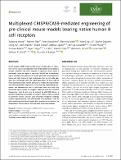| dc.contributor.author | Wang, Xuesong | |
| dc.contributor.author | Ray, Rashmi | |
| dc.contributor.author | Kratochvil, Sven | |
| dc.contributor.author | Melzi, Eleonora | |
| dc.contributor.author | Lin, Ying‐Cing | |
| dc.contributor.author | Giguere, Sophie | |
| dc.contributor.author | Xu, Liling | |
| dc.contributor.author | Warner, John | |
| dc.contributor.author | Cheon, Diane | |
| dc.contributor.author | Liguori, Alessia | |
| dc.contributor.author | Groschel, Bettina | |
| dc.contributor.author | Phelps, Nicole | |
| dc.date.accessioned | 2024-11-05T19:44:52Z | |
| dc.date.available | 2024-11-05T19:44:52Z | |
| dc.date.issued | 2020-12-01 | |
| dc.identifier.uri | https://hdl.handle.net/1721.1/157495 | |
| dc.description.abstract | B‐cell receptor (BCR) knock‐in (KI) mouse models play an important role in vaccine development and fundamental immunological studies. However, the time required to generate them poses a bottleneck. Here we report a one‐step CRISPR/Cas9 KI methodology to combine the insertion of human germline immunoglobulin heavy and light chains at their endogenous loci in mice. We validate this technology with the rapid generation of three BCR KI lines expressing native human precursors, instead of computationally inferred germline sequences, to HIV broadly neutralizing antibodies. We demonstrate that B cells from these mice are fully functional: upon transfer to congenic, wild type mice at controlled frequencies, such B cells can be primed by eOD‐GT8 60mer, a germline‐targeting immunogen currently in clinical trials, recruited to germinal centers, secrete class‐switched antibodies, undergo somatic hypermutation, and differentiate into memory B cells. KI mice expressing functional human BCRs promise to accelerate the development of vaccines for HIV and other infectious diseases. | en_US |
| dc.publisher | Nature Publishing Group UK | en_US |
| dc.relation.isversionof | https://doi.org/10.15252/embj.2020105926 | en_US |
| dc.rights | Creative Commons Attribution | en_US |
| dc.rights.uri | https://creativecommons.org/licenses/by/4.0/ | en_US |
| dc.source | Nature Publishing Group UK | en_US |
| dc.title | Multiplexed CRISPR/CAS9‐mediated engineering of pre‐clinical mouse models bearing native human B cell receptors | en_US |
| dc.type | Article | en_US |
| dc.identifier.citation | The EMBO Journal. 2020 Dec 01;40(2):EMBJ2020105926 | en_US |
| dc.contributor.department | Ragon Institute of MGH, MIT and Harvard | en_US |
| dc.relation.journal | The Embo Journal | en_US |
| dc.eprint.version | Final published version | en_US |
| dc.type.uri | http://purl.org/eprint/type/JournalArticle | en_US |
| eprint.status | http://purl.org/eprint/status/PeerReviewed | en_US |
| dc.date.updated | 2024-10-27T17:16:47Z | |
| dc.language.rfc3066 | en | |
| dc.rights.holder | The Author(s) | |
| dspace.date.submission | 2024-10-27T17:16:47Z | |
| mit.journal.volume | 40 | en_US |
| mit.journal.issue | 2 | en_US |
| mit.license | PUBLISHER_CC | |
| mit.metadata.status | Authority Work and Publication Information Needed | en_US |
